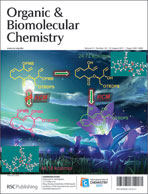Density functional theory calculations (B3LYP) have been carried out to understand the mechanism and stereochemistry of an asymmetric reductive aldol reaction of benzaldehyde and tert-butyl acrylate with hydrosilanes catalyzed by Rh(Phebox-ip)(OAc)2(OH2). According to the calculations, the reaction proceeds via five steps: (1) oxidative addition of hydrosilane, (2) hydride migration to carbon–carbon double bond of tert-butyl acrylate, which determines the chirality at C2, (3) tautomerization from rhodium bound C-enolate to rhodium bound O-enolate, (4) intramolecular aldol reaction, which determines the chirality at C3 and consequently the anti/syn-selectivity, and (5) reductive elimination to release aldol product. The hydride migration is the rate-determining step with a calculated activation energy of 23.3 kcal mol−1. In good agreement with experimental results, the formation of anti-aldolates is found to be the most favorable pathway. The observed Si-facial selectivity in both hydride migration and aldol reaction are well-rationalized by analyzing crucial transition structures. The Re-facial attack transition state is disfavored because of steric hindrance between the isopropyl group of the catalyst and the tert-butyl acrylate.

You have access to this article
 Please wait while we load your content...
Something went wrong. Try again?
Please wait while we load your content...
Something went wrong. Try again?


 Please wait while we load your content...
Please wait while we load your content...